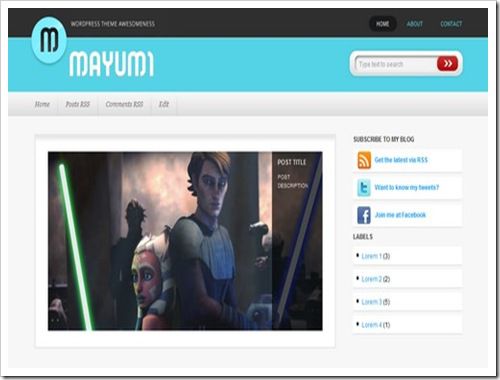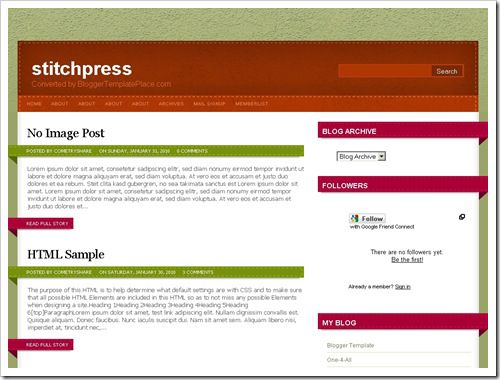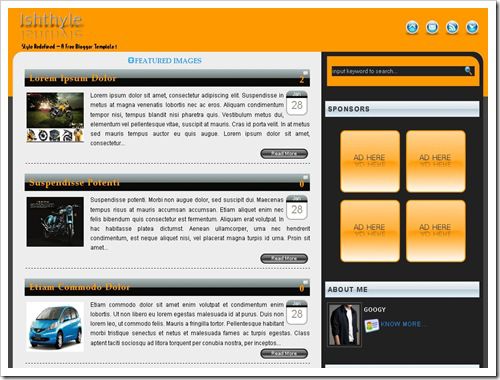
Custom Search
Home » Posts filed under Blogger Templates
Showing posts with label Blogger Templates. Show all posts
Showing posts with label Blogger Templates. Show all posts
Special Post: How to Add Favicons to Blogger Blogs?
While
it is very easy to add a favicon into self-hosted blogs, it is not so
in case of free hosts like Blogspot blogs. The procedure is entirely
different. In Blogger, you have access only to the blog layout and no
file upload features. In this case, adding a favicon to your Blogspot
blog requires a workaround. Here is the step-by-step procedure for that.
- Create Your Own Favicon
The
first step of adding the favicon is creating your own unique favicon
file. The favicon is a very small icon file with ‘.ico’ extension. Use
one of these online services to create your favicon:
You can either upload an image file (in JPG, PNG, or GIF) and get it converted to a favicon or draw your own favicon.
My favicon was drawn, with a clear concept (see below) with the service from:
I loved their paintbrush interface to draw colors into the square columns.
- Upload the Icon File
Once
you have your favicon ready, upload it to a web location, from where it
can be accessed by Blogger. Remember, icon file is a small image file
with ‘.ico’ extension. But, it cannot be uploaded to Flickr as an image.
It is worthless to upload to Rapidshare or any such file sharing
systems. So, what I did was create a free webpage with Googlepages, and upload the file there.
For that, you have to sign up in Googlepages and create a free web space there (here is my site: lenxworld.googlepages.com).
In this account, you have the privilege to upload any sort of files as
in self-hosted blogs. Here is the screenshot of the file upload feature.
- Add This Script to Your Blog
As
the third step, in your Blogger profile, go to layout and click ‘Edit
HTML’. Then, just add the following code after your code’s title tag:
<link href='Your Icon URL' rel='shortcut icon'type='image/vnd.microsoft.icon'/>
On adding this script, please replace the Your Icon URL with the correct URL of your favicon.
Once you have this script ready, save the template and check the website, your favicon should be loading fine.
I
tested my site with Mozilla Firefox, Internet Explorer, and Opera. In
all, the favicon is showing just fine. In case of IE, the favicon load
time (for CuteWriting) is rather long, but it is only a special case. In
case of IE engine loaded within Firefox, the favicon doesn’t work for
any website.
Thanks to Tips for new bloggers article, which formed the basis of this tutorial.
About My Favicon
As
you see, my favicon consists of four colors on a black background. It
is meant as a symbol of cooperation to spread the light of knowledge.
Materialistically, it is the confluence of the basic colors, blue,
green, and red to form white.
Now
let’s get to its envisioned meaning. Blue emanating from the bottom
represents my this blog, CuteWriting. It is a contribution to the good
of the society. The green from the side is the general acceptance to the
blog—my readers who support me. The red from above is the healthy
criticism I receive (intended to be coming against blue). All these
three colors congregate to form the white line, which is the bright
light of wisdom and knowledge.
The
white light proceeds from there, and lights all the way through the
society.
We are working together to make the world a better place. So,
it basically means that your contributions and criticisms are required
for the success of this quest for knowledge.
Create An Image SlideShow
Finally here comes the third and final tutorial for creating a image
slide-show. In this widget, the text layers will appear from any of the
four sides (left, right, top, bottom).
Demo: s3Slider Demo [Example 3]
Introductory post: Create An Image SlideShow - Part 1.
SLIDE-SHOW
Instructions to add this widget:
STEP 1:
Download these files:
jquery.js
s3Slider.js
Download them as a zipped file
STEP 2:
Upload both the files to either MyDataNest.com or SigMirror.com (you need to register first), and get the DIRECT LINKS to the files.
STEP 3:
The coding part:
Log in to Blogger, go to Layout -> Edit HTML
Now find this in the template code:
Replace the links in red, with the DIRECT LINKS you got from the second step, and save the template.
STEP 4:
For smaller Widget (width=370px)
Then go to Layout -> Page Elements
And click on "Add a Gadget", select it as "HTML/JavaScript" type.
And this content to the widget:
For larger Widget (width=680px)
Then go to Layout -> Page Elements
And click on "Add a Gadget", select it as "HTML/JavaScript" type.
And this content to the widget:
Now replace the links in red with the Direct Links to your own images.
Change the Class="left/right" to display the text at either left or right of the widget,
and also change the titles and content (in blue).
Finally save the widget. And drag the widget to wherever you like. You may also directly embed the widget in a blog post. If you want to use the other two widgets, then wait for the next posts.
Demo: s3Slider Demo [Example 3]
Introductory post: Create An Image SlideShow - Part 1.
SLIDE-SHOW
Instructions to add this widget:
STEP 1:
Download these files:
jquery.js
s3Slider.js
Download them as a zipped file
STEP 2:
Upload both the files to either MyDataNest.com or SigMirror.com (you need to register first), and get the DIRECT LINKS to the files.
STEP 3:
The coding part:
Log in to Blogger, go to Layout -> Edit HTML
Now find this in the template code:
</head>And immediately ABOVE/BEFORE it, add these lines:
<!--SLIDE-SHOW-STARTS-->
<!-- CSS -->
<style type="text/css" media="screen">
#slider {
width: 410px; /* important to be same as image width */
height: 300px; /* important to be same as image height */
position: relative; /* important */
overflow: hidden; /* important */
}
#slider1 {
width: 720px; /* important to be same as image width */
height: 300px; /* important to be same as image height */
position: relative; /* important */
overflow: hidden; /* important */
}
#sliderContent, #slider1Content {
width: 720px; /* important to be same as image width or wider */
position: absolute;
top: 0;
margin-left: 0;
}
.sliderImage, .slider1Image {
float: left;
position: relative;
display: none;
}
.sliderImage span {
position: absolute;
font: 10px/15px Arial, Helvetica, sans-serif;
padding: 10px 13px;
width: 384px;
background-color: #000;
filter: alpha(opacity=70);
-moz-opacity: 0.7;
-khtml-opacity: 0.7;
opacity: 0.7;
color: #fff;
display: none;
}
.slider1Image span {
position: absolute;
font: 10px/15px Arial, Helvetica, sans-serif;
padding: 10px 13px;
width: 694px;
background-color: #000;
filter: alpha(opacity=70);
-moz-opacity: 0.7;
-khtml-opacity: 0.7;
opacity: 0.7;
color: #fff;
display: none;
}
.clear {
clear: both;
}
.sliderImage span strong, .slider1Image span strong {
font-size: 14px;
}
.top {
top: 0;
left: 0;
}
.bottom {
bottom: 0;
left: 0;
}
.left {
top: 0;
left: 0;
width: 110px !important;
height: 280px;
}
.right {
right: 0;
bottom: 0;
width: 90px !important;
height: 290px;
}
ul { list-style-type: none;}
</style>
<!-- JavaScripts-->
<script type="text/javascript" src="http://mydatanest.com/........./jquery.js"></script>
<script type="text/javascript" src="http://mydatanest.com/........./s3Slider.js"></script>
<script type="text/javascript">
$(document).ready(function() {
$('#slider').s3Slider({
timeOut: 3000
});
$('#slider1').s3Slider({
timeOut: 4000
});
});
</script>
<!--SLIDE-SHOW-STOPS-4-HELP-http://bloggerstop.net-->
Replace the links in red, with the DIRECT LINKS you got from the second step, and save the template.
STEP 4:
For smaller Widget (width=370px)
Then go to Layout -> Page Elements
And click on "Add a Gadget", select it as "HTML/JavaScript" type.
And this content to the widget:
<div id="slider">
<ul id="sliderContent">
<li class="sliderImage">
<a href=""><img src="images/410/1.jpg" alt="1" /></a>
<span class="top"><strong>Title text 1</strong><br />Content text...</span>
</li>
<li class="sliderImage">
<a href=""><img src="images/410/2.jpg" alt="2" /></a>
<span class="top"><strong>Title text 2</strong><br />Content text...Content text...Content text...Content text...Content text...Content text...Content text...Content text...Content text...Content text...Content text...</span>
</li>
<li class="sliderImage">
<img src="images/410/3.jpg" alt="3" />
<span class="bottom"><strong>Title text 3</strong><br />Content text...</span>
</li>
<li class="sliderImage">
<img src="images/410/4.jpg" alt="4" />
<span class="bottom"><strong>Title text 4</strong><br />Content text...</span>
</li>
<li class="sliderImage">
<img src="images/410/5.jpg" alt="5" />
<span class="top"><strong>Title text 5</strong><br />Content text...</span>
</li>
<div class="clear sliderImage"></div>
</ul>
</div>
For larger Widget (width=680px)
Then go to Layout -> Page Elements
And click on "Add a Gadget", select it as "HTML/JavaScript" type.
And this content to the widget:
<div id="slider1">
<ul id="slider1Content">
<li class="slider1Image">
<a href=""><img src="images/wide/1.jpg" alt="1" /></a>
<span class="left"><strong>Title text 1</strong><br />Content text...</span></li>
<li class="slider1Image">
<a href=""><img src="images/wide/2.jpg" alt="2" /></a>
<span class="right"><strong>Title text 2</strong><br />Content text...Content text...Content text...Content text...Content text...Content text...Content text...Content text...Content text...Content text...Content text...</span></li>
<li class="slider1Image">
<img src="images/wide/3.jpg" alt="3" />
<span class="right"><strong>Title text 2</strong><br />Content text...</span></li>
<li class="slider1Image">
<img src="images/wide/4.jpg" alt="4" />
<span class="left"><strong>Title text 2</strong><br />Content text...</span></li>
<li class="slider1Image">
<img src="images/wide/5.jpg" alt="5" />
<span class="right"><strong>Title text 2</strong><br />Content text...</span></li>
<div class="clear slider1Image"></div>
</ul>
</div>
Now replace the links in red with the Direct Links to your own images.
Change the Class="left/right" to display the text at either left or right of the widget,
and also change the titles and content (in blue).
Finally save the widget. And drag the widget to wherever you like. You may also directly embed the widget in a blog post. If you want to use the other two widgets, then wait for the next posts.






